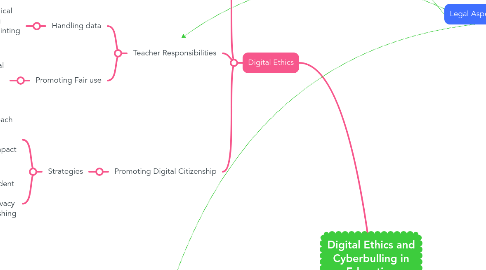
1. Digital Ethics
1.1. Ethical Dilemmas
1.1.1. Privacy
1.1.1.1. Deciding whether to monitor students online activities to prevent cyberbullying vs respecting their privacy
1.1.2. Access to technology
1.1.2.1. Ensuring all students have equal access to digital resources, preventing a divide that can lead to exclusion or harassment
1.2. Teacher Responsibilities
1.2.1. Handling data
1.2.1.1. Teachers must ensure the ethical use of student data, avoiding unauthorised sharing and mainting confidentiality
1.2.2. Promoting Fair use
1.2.2.1. Educate students about the ethical use of digital content, including understanding copyrights and avoiding plagiarism.
1.3. Promoting Digital Citizenship
1.3.1. Strategies
1.3.1.1. Respectful Communication: Teach students the importance of respectful interactions online, highlighting how words can impact others
1.3.1.2. Online Safety: Education student on how to stay safe online, including how to manage privacy settings and recognising phishing attempts.
2. Cyberbulling
2.1. Prevention and Managment
2.1.1. Educational strategies
2.1.1.1. Implement school wide digital citizenship programs that teach students about the conseuqneces of cyberbullying and the importance of empathy online
2.1.2. Policy Enforcement
2.1.2.1. Establish clear school policies that define unacceptable behaviours and the consequences for cyberbullying, ensuring these are well communicated to all students.
2.2. Experiences of Pre Service Teachers
2.2.1. Common scenarios and effects
2.3. Understanding Cyberbullying
2.3.1. Definition
2.3.1.1. Cyberbullying involves the use of electronic communication to bully a person, typically by sending messages of an intimidating or threatening nature.
2.3.2. Examples
2.3.2.1. Textual Harrassment: Sending threatening texts or emails
2.3.2.2. Image based abuse: Posting embarrasing or harmful images online without conset
2.3.2.3. Impersonation: Creating a fake profile to harass someone
2.3.2.4. Exclusion: Intentionally leaving someone out of an online chat or activity
